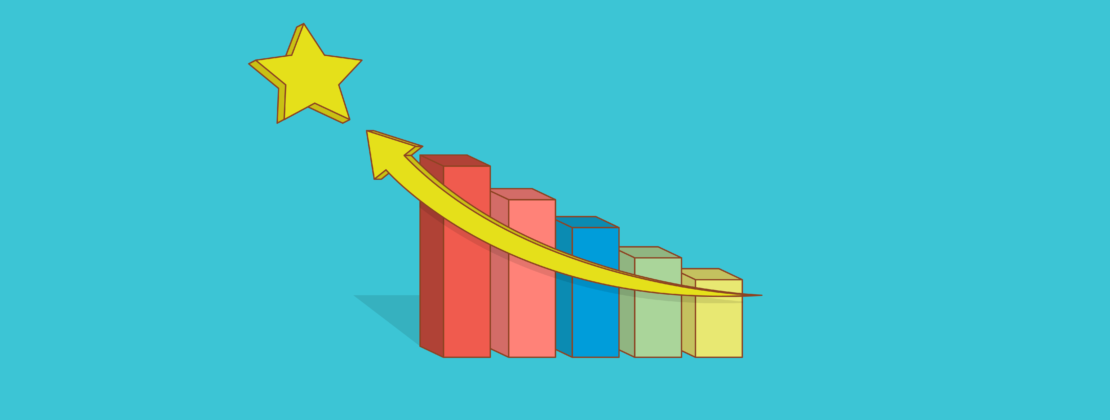It’s easier to retain existing customers than it is to attract new ones. Some reports show that acquiring new customers is up to five times more expensive than retaining existing customers. That goes a long way to show just how critical it is to nurture your existing customer base. It’s cheaper, less tedious, and the ROI is well worth it.
But how can you generate more revenue from the same customers?
One way is upselling. This post will show you how to upsell through emails. Before we get to that, let’s look at some of the key aspects of an upsell email campaign.
Content:
- Six elements of an upsell email campaign
- Customized greetings
- Items that have been recently purchased
- Segmentation
- Contact information and help options
- Buttons for social sharing
- Option to opt out
- Five different types of upsell emails
- Product recommendation emails
- Trial expiry emails
- Upsell emails for a more deluxe subscription
- Product launch emails
- Thank you emails
- Wrapping up
Six elements of an upsell email campaign
The first step to creating an effective campaign is understanding what a great upsell strategy looks like. So here are the six components of a great upsell email campaign.
Customized greetings
Personalization is important in marketing. There are various ways of personalizing your upselling emails. One of the easiest yet most effective techniques is through customized greetings.
You can personalize your email greetings by mentioning the subscriber’s name — that’s what all smart marketers do.
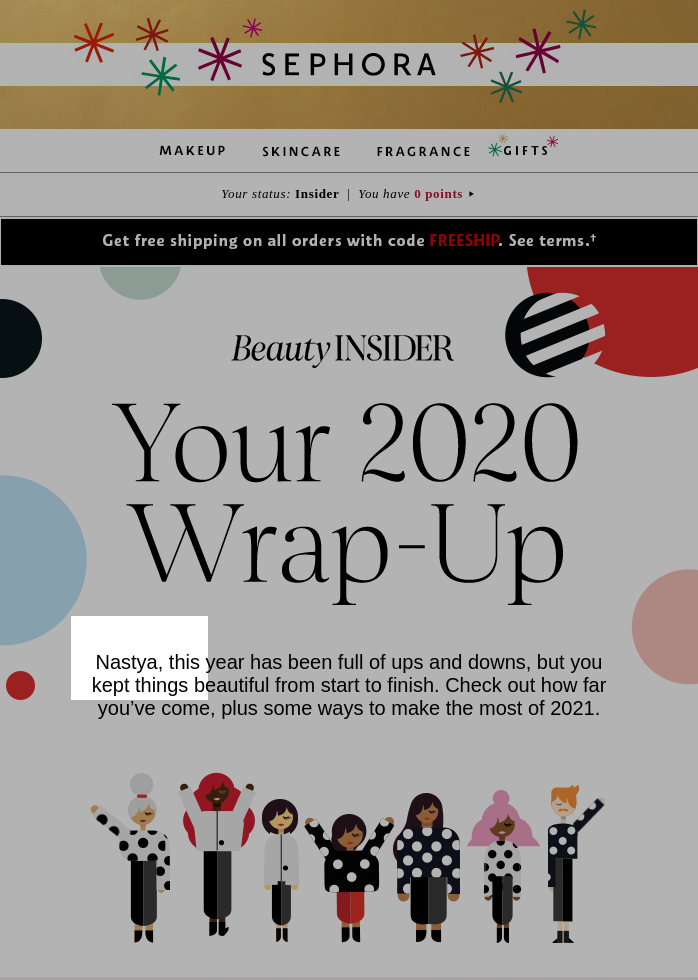
Sephora understands the power of personalized greetings. They reward customers who have made a certain number of purchases by offering them exclusive discounts on new products. And this brings us nicely to our next point.
Items that have been recently purchased
A good upsell shows the customer why they should upgrade to a more expensive version of your product. Your upsell email needs to show or mention the product you want the customer to upgrade from.
By discussing their current solution and demonstrating why they need the upgrade, your email will look less like an upsell and more like expert advice. That’s what you want. Customers will see that you’re not just trying to make an extra buck from them. But instead, you’re offering a practical solution based on their previous interactions with your brand.
The second benefit is it makes the upsell email feel personalized. Your email has to show that you understand the customer and their pain points. That’s why referencing a recently bought item is so important. The customer will see that you’re not pulling the upsell out of thin air. It’s something you’ve thought through. That’ll make them more receptive to your calculated pitch.
Segmentation
Mailing list segmentation is a must. Without it, you’ll end up sending irrelevant upselling emails to customers. Not only is this bad for your open and click-through rate, but it may also increase your unsubscribe rate.
Create and implement an effective mailing list segmentation strategy. Research your audience and identify common interests to group them by.
For upselling, you should segment your list based on purchasing history. You can consider factors like location or behavioral patterns. Think about the targeted email marketing campaign you want to run and find the appropriate segmentation method.
Proper segmentation will get you better open rates, click-through rates, and more conversions. It is so effective that a vast majority of email marketers use mailing list segmentation or its derivative practices to improve their email campaign performance.
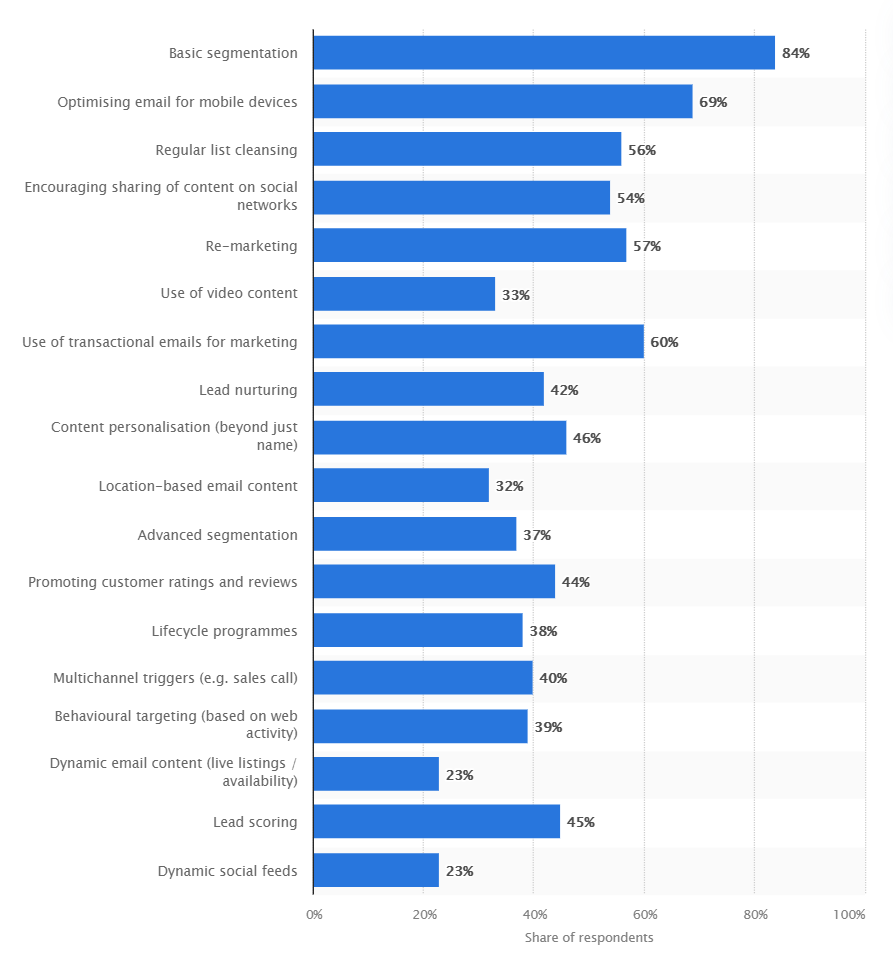
Once you have your subscribers segmented, create unique newsletter templates for each group. You should have a separate email sequence for every group since they have different needs and interests.
Contact information and help options
Customers will want additional information before committing to a new, more expensive plan.
Let’s say you’re trying to market your guest post services to an existing client. You want them to upgrade from a plan that costs a few hundred dollars to $1,000+ per month. That’s a huge jump, and it will surely affect their budget. Therefore, they’ll naturally want to get in touch to understand what rankings, traffic, etc., to expect in return for the increased pricing.
And here is the other thing, an email is not enough. If you’re trying to get a client to upgrade to a more expensive service or product, you better be ready to talk to them directly. It’s only fair, right? Remember that this is an investment. Prepare to communicate through several channels.
Buttons for social sharing
Upsell emails present an excellent opportunity to build brand awareness. All you have to do is include social share buttons and encourage your loyal customers to share your message with their friends.
One of the most effective ways of boosting social shares is by providing discounts and other freebies. These offers will incentivize more clients to share your emails.
Generate unique invite codes or links for your customers and tell them they’ll get a discount for every purchase done via the code or link. Make the deal even better by providing an additional discount for the people buying through your customer’s invite codes.
Option to opt out
Most countries have regulations that require businesses to provide an unsubscribe option in their emails. You have to follow this practice not just because anti-spam laws require it but also because it’s suitable for your brand.
Consumers love honest and transparent brands. Making it easy for subscribers to opt out of your mailing list is one of the easiest ways to achieve that.
Five different types of upsell emails
There are five major types of upsell emails. You are free to use as many of them as possible but don’t be too pushy. Here is how these emails work.
Product recommendation emails
One of the easiest ways of identifying an upselling opportunity is by analyzing your customer’s purchase history. Just look at the products they’ve bought recently and identify a relevant upgrade.
Using product recommendations to upsell customers is very common on eCommerce sites. You will find a store upselling a client from a 128GB iPhone to a 256GB iPhone. That’s a relevant and reasonable pitch.
You can implement the same approach through emails. For instance, streaming platforms like Netflix use upselling emails to get clients to sign up for a premium plan. The pitch here is that the customer will enjoy better video quality, more streaming devices, and so on for a small additional fee.
Even eCommerce businesses can use emails to upsell and cross-sell products to a customer who’s just completed a purchase.
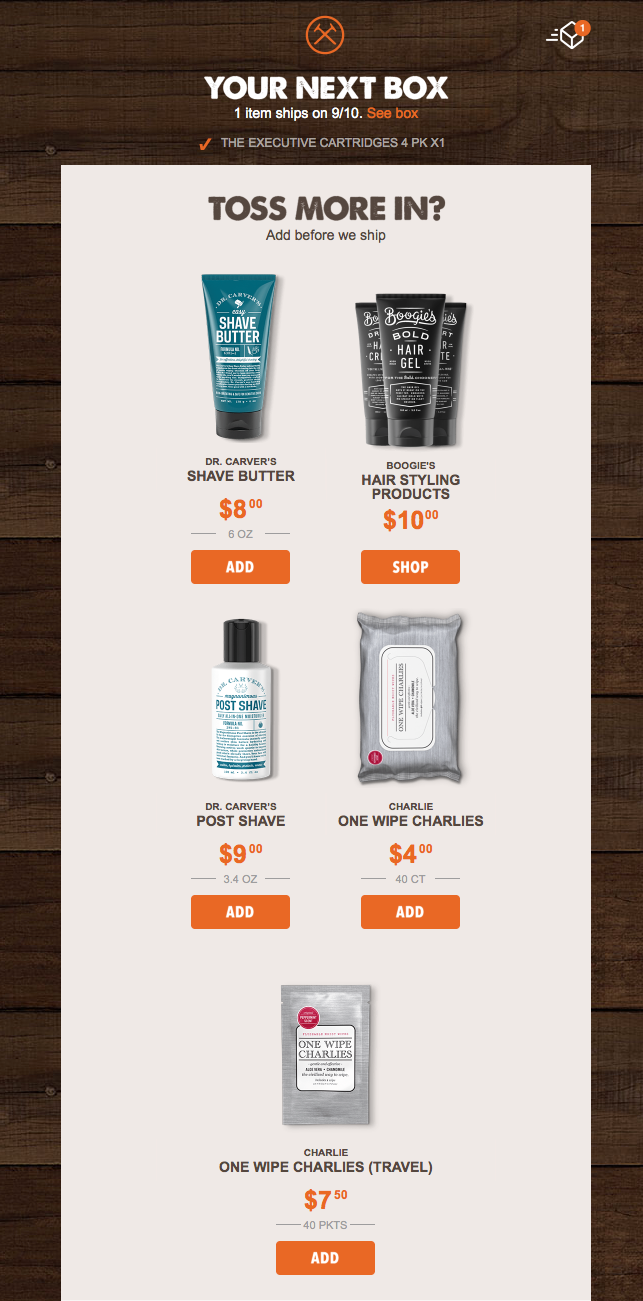
Dollar Shave Club has a subscription plan for its clients. They typically send the above email once per month before shipping the client’s product. It recommends multiple products that are relevant to the client’s needs. The convenience of having all of your items shipped at once makes the pitch even better.
Trial expiry emails
Offering a free trial is a common lead generation strategy for SaaS companies. These businesses give prospects a free ride on their software in exchange for an email address. They then initiate an email marketing campaign to nurture the leads.
One of the most important emails in these campaigns is the trial expiry email. The email is used to remind clients that their trial is coming to an end. But there’s more to it than that.
You can use a trial to market paid plans. Just mention all of the premium features your customer will unlock when they upgrade to the paid version of your software. Then, demonstrate how said features will improve their workflow. You can even go as far as using social proof to show how other businesses are benefiting from the product.
Here’s a good example from Loom.
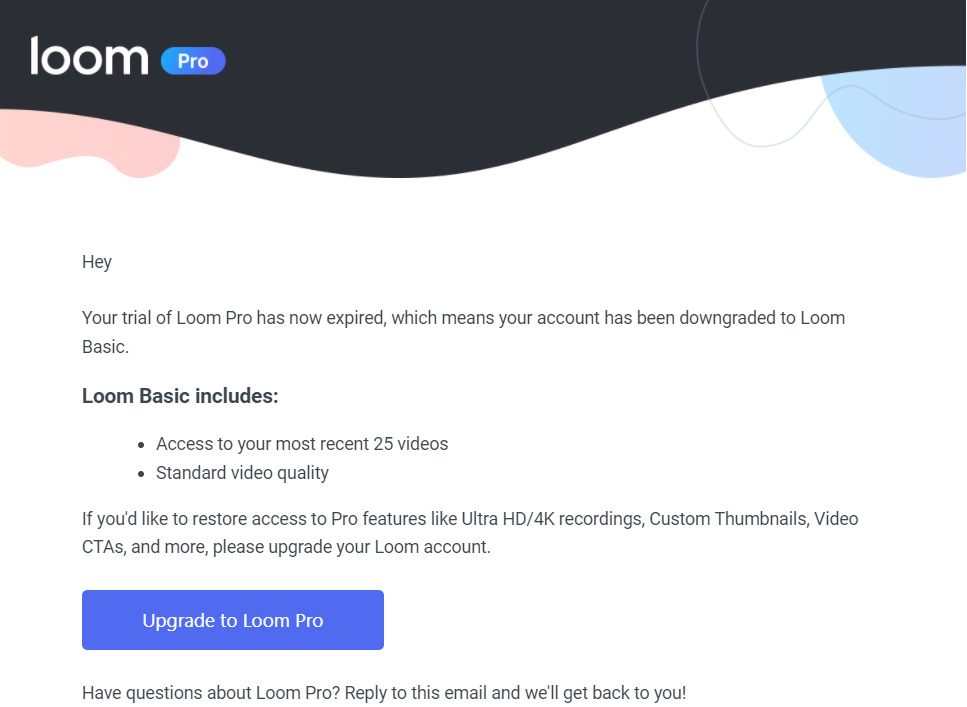
The email points out all of the professional features the user will miss out on if they get downgraded to a basic account. They also suggest a way to keep using those features, making the email more personal
While I received the above email after my trial expired, trial expiry emails work best when sent before the trial is over. You want to reach your customers while they’re still enjoying your incredible product. The mere inconvenience of disrupted services might just be enough to get them to convert.
You should also incentivize your users to sign up for a paid plan before the trial expires. How do you do that? Simple — give them a time-sensitive discount for the first subscription.
Limited time offers is one of the tactics in the playbook of Grammarly’s marketers.
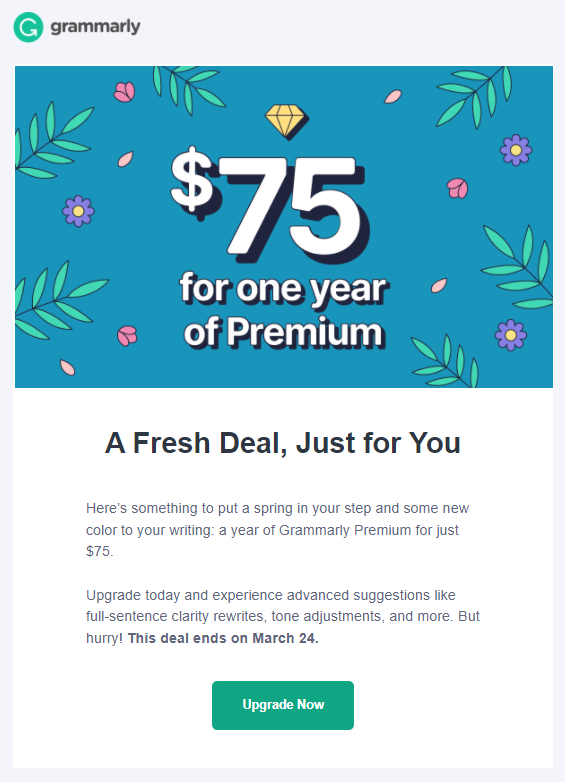
The offer is a good incentive to nudge the lead into becoming a paying customer. But you need to create a sense of urgency to speed up the conversion. In the email upsell example above, the customer needs to upgrade by a specific date to enjoy the discounted price.
Upsell emails for a more deluxe subscription
Using emails to upsell clients to a more deluxe subscription is a technique used by many SaaS companies. You will, for instance, come across an email marketing software provider upselling a client from a basic plan to a standard plan. Or a standard plan to the premium version.
It’s a pretty straightforward tactic, and it works like a charm. But, you have to be practical.
Remember that the upsell needs to make sense to your clients. Upselling the most expensive plan to a business that’s barely utilizing the basic features is anything but sensible. The pitch won’t work.
So analyze your customer’s usage patterns and overall needs, then match them with a sensible upgrade. The good news is that you’ll have plenty of data to work with since the customers are already using your product. That means you know which features they max out each month and what they are not using. You can even use this data to create a custom plan just for them.
Dropbox uses a similar approach. Here’s one of their emails.
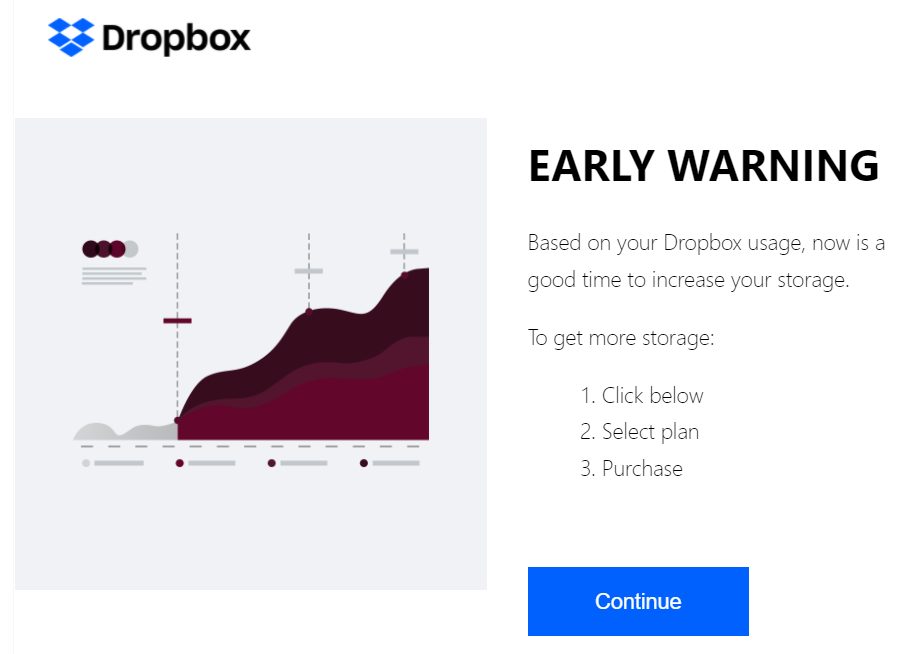
The email capitalizes on the fact that the customer has already used the platform, which means they know its value. But then the pitch comes in, informing the user that they can “unlock the true power” of the app with faster speeds and more storage. All they have to do is upgrade. It’s a simple but effective strategy.
Product launch emails
These emails are super effective at creating a buzz around a new product entering the market. All big companies use product launch emails.
Adidas sends out emails marketing their latest products to their existing customers. They will highlight everything different and better about the new product. In the case of the email below, they even emphasized that their new Lego-inspired sneaker line is also suitable for grown-ups.
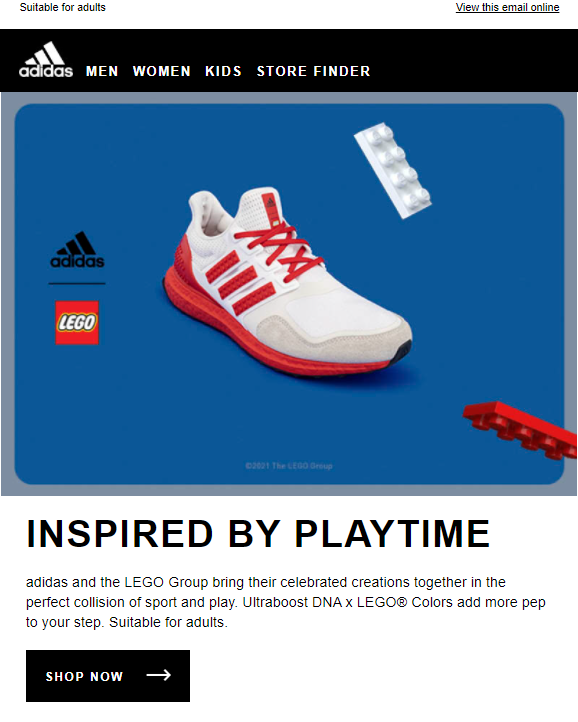
These emails get people hyped about the product hence attracting more brand and product visibility. So they trigger existing customers to upgrade while attracting new prospects.
Virtually any other business can use the same approach. Whether it’s a new product or service, a product launch email campaign helps you spread the word about your newest service. But more importantly, it shows existing customers why they seriously need to consider the upgrade.
Thank you emails
Most online businesses have an automated thank you email. The email is triggered every time a customer completes a purchase. For some companies, this email rarely says anything else besides the thank you. But did you know that you can also upsell the customer in this email?
And yes, it’s a bit tricky since you don’t want customers to think you just want more of their money. But it’s doable nonetheless. You just need a calculative approach.
Check out this upsell email example from LinkedIn.
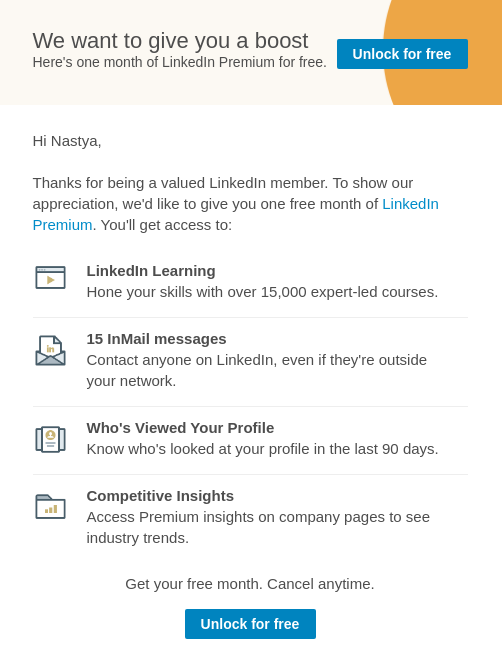
The tone of this email is super warm. You can tell that the company is genuinely grateful. But once you get past “You’ll get access to,” it’s pretty obvious that LinkedIn is selling you its Premium product by listing its features. The pitch isn’t bad either as it speaks to its users’ main concerns: being aware of who’s viewed their profiles and expanding their network through dedicated messaging. By offering a free trial, they hope to convert the user into a paying customer.
Wrapping up
We’ve seen five types of these emails and talked about what they can do for your brand. You can upsell via product recommendations, trial expiry emails, subscription upgrades, product launch emails, and thank you emails. Whichever campaign you choose, make sure all the upsell emails have the six components discussed above.
Lastly, remember this: you have to target the right audience with the right message at the perfect time. Don’t upsell to just about anyone. That’s the easiest way to lose a customer’s trust. Instead, find people who can benefit from your highly-priced product. Next, get the message right by pitching a product that makes sense to the customer. Explain its value. Finally, make the pitch at the right time.
